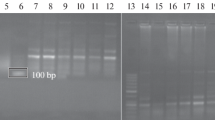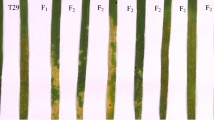Summary
A factor for resistance to yellow rust in the Iranian spelt wheat accession 415 was found to be located on chromosome 1B, utilizing a monosomic series of T. spelta var. saharense. Ditelosomic stocks of cv. Chinese Spring, were employed to verify the identity of the critical chromosome. The factor for resistance is most probably identical with the Yr10 allele which is also located on chromosome 1B. Moreover, the response of cv. Moro which carries Yr10 and accession 415 to 22 yellow rust races, representing a wide pathogenicity spectrum, was identical.
Similar content being viewed by others
References
El-Bedewy, R., 1981. Monosomen-analyse der Resistenz gegenüber Gelbrost (Puccinia striiformis West.) beim Weizen, Triticum aestivum L. Ph.D. thesis, Göttingen University, 58 pp.
El-Bedewy, R., T. Attia & G. Röbbelen, 1982. Development of a monosomic series in the hexaploid T. spelta var. saharense universally susceptible to yellow rust. Egypt. J. Genet. Cytol. 11: 175–181.
Gerechter-Amitai, Z.K., C.H. van Silfhout & A. Grama, 1989. Yr15—a new gene for resistance to Puccinia striiformis in Triticum dicoccoides sel. G-25. Euphytica 43: 187–190.
Harlan, J.R., 1976. Diseases as a factor of plant evolution. Ann. R. Phyto. 14: 31–51.
Johnson, R., R.W. Stubbs, E. Fuchs & N.H. Chamberlain, 1972. Nomenclature for physiologic races of Puccinia striiformis infecting wheat. Trans. Br. Mycol. Soc. 58: 475–480.
Kema, G.H.J., 1988. An undescribed allele for resistance to yellow rust (Puccinia striiformis Westend. f. sp. tritici) in Triticum aestivum ssp. spelta 415. Proc. 7th Europ. Mediterr. Cereal Rusts Conf., Vienna, Austria: 27–29.
Kema, G.H.J., 1992a. Resistance in spelt wheat to yellow rust. I. Formal analysis and variation for gliadin patterns. Euphytica 63: 207–217.
Kema, G.H.J., 1992b. Resistance in spelt wheat to yellow rust. III. Phylogenetical considerations. Euphytica 63: 225–231.
Kimber, G. & E.R. Sears, 1983. Assignment of genome symbols in the Triticeae. Proc. 6th Int. Wheat Genet. Symp., Kyoto, Japan: 1195–1196.
Kimber, G. & E.R. Sears, 1987. Evolution in the genus Triticum and the origin of cultivated wheat. In: E.G. Heyne (Ed.), Wheat and Wheat Improvement. Agronomy 13, 2nd edition, Madison, Wisconsin: 154–163.
Kuckuck, H. & E. Schiemann, 1957. Über das Vorkommen von Spelz und Emmer (Triticum spelta L. und T. dicoccum Schübl.) im Iran. Z. Pflanzenzücht. 38: 383–396.
Macer, R.C.F., 1963. The formal and monosomic genetic analysis of stripe rust (Puccinia striiformis) resistance in wheat. Proc. 2nd Int. Wheat Genet. Symp., Lund, Hereditas Suppl. 2: 127–142.
Macer, R.C.F., 1975. Plant pathology in a changing world. Trans. Br. Mycol. Soc. 65: 351–374.
McIntosh, R.A., 1987. Gene location and gene map** in hexaploid wheat. In: E.G. Heyne (Ed.), Wheat and Wheat Improvement. Agronomy 13, 2nd edition, Madison, Wisconsin: 269–287.
McIntosh, R.A., 1988. A catalogue of gene symbols for wheat. In: T.E. Miller & R.M.D. Koedner (Eds.), Proc. 7th Int. Wheat Genet. Symp., Cambridge, England: 1225–1323.
Metzger, R.J. & B.A. Silbaugh, 1970. Inheritance of resistance to stripe rust and its association with brown glume color in Triticum aestivum L., ‘P.I. 178383’. Crop Sci. 10: 567–568.
Riley, R., 1969. Evidence from phylogenetic relationships of the types of bread wheats first cultivated. In: F.J. Ucko & G.W. Dimbleby (Eds.), The Domestication and Exploitation of Plants and Animals. Gerald Duckworth & Co, London: 173–176.
Russell, P.G., 1956. Plant material introduced January 1 to December 31, 1949 (Nos. 172311–185795). Plant inventory no. 157. U.S.D.A, Washington.
Stubbs, R.W., 1985. Stripe Rust. In: A.P. Roelfs & W.R. Bushnell (Eds.), The Cereal Rusts II. Academic Press, New York: 61–101.
Tottman, D.R. & R.J. Makepeace, 1979. An explanation of the decimal code for the growth stages of cereals, with illustrations. Ann. Appl. Biol. 93: 221–234.
Vallavieille-Pope, C. de & R.F. Line, 1990. Virulence of North American and European races of Puccinia striiformis on North American, World, and European differential wheat cultivars. Plant Dis. 74: 739–743.
Zeven, A.C., 1969. Fourth supplementary list of wheat varieties classified according to their genotype for hybrid necrosis. Euphytica 18: 43–57.
Author information
Authors and Affiliations
Rights and permissions
About this article
Cite this article
Kema, G.H.J., Lange, W. Resistance in spelt wheat to yellow rust. Euphytica 63, 219–224 (1992). https://doi.org/10.1007/BF00024547
Accepted:
Issue Date:
DOI: https://doi.org/10.1007/BF00024547




